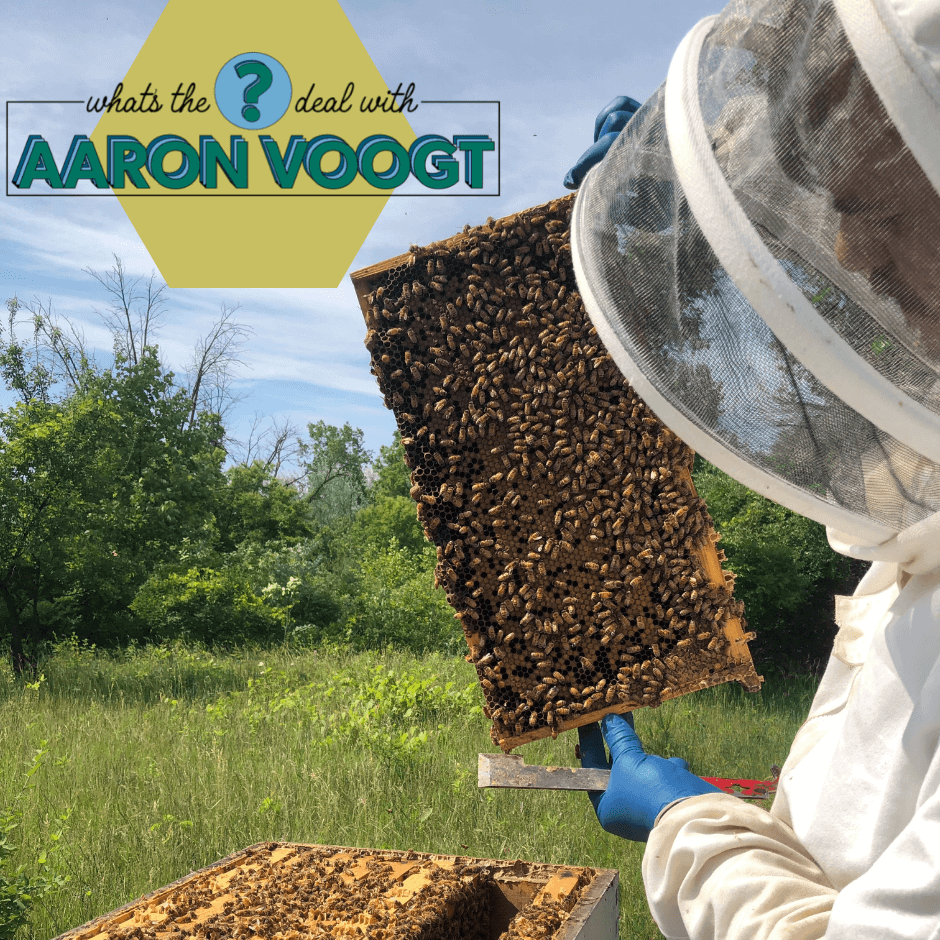
Revisit this reader favorite from 2022.
I am standing in front of eight rumbling beehives.
They’re tucked between a construction yard and a marshy riverside – not a place I would have thought bees could thrive, yet here they are.
Their keeper, dressed in a white protective suit and netted hood, fearlessly reaches for the buzzing hives. I know that before the day is over, I’ll have to do that, too, and I also know that the kid in Jerry Maguire said bees can smell fear…though I don’t remember if he said fear makes them attack. None of this is calming.
The beekeeper I’ve called on is Jason Osbourn, who owns Aberdeen Apiary in Grand Rapids. He’s an attorney but before going to law school, he was a sheriff’s deputy and a service member in the US Army and Marines Corps. He tends his 500,000 bees in his spare time, and to do it, he drives a 1980s Chevy pickup that’s painted bright yellow with a black stripe running down the side. He’s the kind of person who says that compared to the drama of the courtroom, stinging bees are a peaceful change of pace – and you believe him.
Jason is an encyclopedia of all things bee, which I learn while accompanying him on today’s hive inspections. This time of year, he does hive inspections weekly, making note of each hive’s health and progress. As he looks over his clipboard, he decides that I’d better suit up. I think that’s smart.
My own protective jacket has zippers and clips sealing every opening a tiny bee could get through. With my world now filtered through mesh netting, I approach the hives and get my first look into these tiny societies.
Flying about the hive entrances, bees leave or land like tiny fighter jets. As Jason lifts the top off the first hive, I see that these hovering foragers are only a fraction of the hive’s inhabitants. Thousands of bees bustle about the interior.

Meet the Bees
If you’ve ever watched a honeybee land delicately on a flower or curiously investigate your colorful t-shirt, you were looking at a worker. Small, sterile, and always female, the worker bees are the bulk of the colony. They have many jobs. Younger workers start inside the hive, caring for the brood (baby bees) or maintaining the hive’s infrastructure. As a worker gets older, she moves to jobs outside the hive, such as defending the colony or foraging for resources.

In the midst of the crawling workers, I see a considerably larger bee. I ask Jason if this is the queen, but he points out the bulging eyes set high on its head. This is a male bee — a “drone.” The drone saunters around the hive, being fed by his sisters and doing absolutely no work. But he and his brothers do have a purpose: to fly out into the world and mate with virgin queens. His huge eyes help him see potential mates, the singular purpose of his life. This is how new colonies start and genetics are passed on, so the workers tolerate him… for now. When winter comes and food is scarce, male drones are thrown out of the hive to die. A gruesome end, but it’s this cold efficiency that makes bees so successful.
Suddenly I see another large bee, but this one is different. It looks like a worker bee, but its abdomen is longer. It parades across the honeycomb, inspecting cells, and sometimes depositing an egg into an empty one. The queen.
Several workers follow, lining the path in front of the queen and attending to her every need. While she isn’t the hive’s leader (bees don’t really need leaders), she’s the mother of every bee in the colony. And as I watch her daughters turn to face her as she passes, there is a regal air about her.

Jason points out brood cells in the honeycomb. A tiny white egg, smaller than a grain of rice, rests at the bottom of a hexagon. More eggs surround it. This is a good sign. Even if Jason can’t find the queen during a hive inspection, finding cells with brood means that she’s doing her job. She’ll lay as many eggs as she can find open cells for, and in three days’ time, the eggs will become larvae. The larvae, ugly white grubs, eat and grow constantly. Eventually, they’ll spin a cocoon, and their cells will be capped with beeswax. From these cells will emerge a new adult worker bee, ready to begin its work.
Jason tells me that during the summer, workers might only live six weeks, working themselves to death. I watch as a worker carries a corpse from the hive and unceremoniously dumps it on the ground. But their efforts are not in vain. Bees are so efficient that they’ll often produce more honey than they’ll ever need, ensuring the colony will never be without food.
This is convenient for humans, who have been farming bees for 9,000 years — longer than we’ve farmed chickens. Or used written language, for that matter.
The Hive
The hive itself is a stack of wooden boxes, or “supers.” Inside each box are rows of removable frames on which the bees build their honeycomb. The entire design is called a Langstroth Hive, invented by Lorrenzo Lorraine Langstroth in 1851. The standard of modern beekeeping, it allows the beekeeper to check on the bees and collect honey without killing the colony. And before the Langstroth Hive, that’s exactly what beekeepers would do; kill the entire colony at the end of the season and extract the honey. The Langstroth Hive allows beekeepers like Jason to work with and cultivate a colony for several years.
Jason pries a frame out with a metal tool, careful not to crush any bees if he can help it. The frame is covered in honeycomb — those famous hexagonal patterned cells. Made from beeswax, a secretion from a bee’s abdomen, the honeycomb cells are multipurpose. Some store brood, while others store honey. The hexagonal shape optimizes storage (circles would leave wasted space), which is an incredible feat of geometry from a creature the size of my pinky nail.

Another bee construction material is called propolis; a sticky substance bees collect from oozing tree sap. They use it to meticulously fill unwanted gaps in their hive, which is great for security and airflow control. Jason tells me propolis also has antibacterial properties. Amazingly, the bees use it to prevent diseases and viruses from spreading throughout the hive.
When a bee is presented with a gap, it will do one of two things. Small gaps are filled with propolis, while larger gaps are filled with honeycomb cells. But between these two areas is a precise measurement that Langstroth called “bee space.” He found that when bees build hives in the wild, they leave openings 3/8 of an inch wide to walk through. The Langstroth Hive has each frame spaced 3/8 of an inch apart to mimic this.

Dancing Directions
As the hive’s foragers come in from the outdoors, there’s an urgency to their rush inside. They bring resources and food, but also information. If one bee finds a particularly useful patch of flowers, she’ll perform a “dance” for her sisters.
This dance is the bee’s way of saying “Hey, here’s where there’s some nectar!” She’ll walk in a direction, wiggling her butt, then turn around and repeat in an opposite direction. As the other bees watch, they’re not just seeing their sister dance. With each butt wiggle and turn of her body, she communicates direction and distance. Jason tells me that their butt wiggling is incredibly accurate.
With directions, the other bees head out to forage. They’ll fly in a 3- to 5-mile radius of the hive, an astronomical distance for a tiny bee. Jason’s bees make it to downtown Grand Rapids, and into the area’s surrounding farmland and suburbs. Covering such a large area opens the colony up to a huge diversity of resources.
I think I see a bee dancing, and point it out to Jason. But before he can respond, a bee darts up and stings my thumb. I yelp and recoil. A small brown stinger hangs off my skin, and as I look at it, I see that down on the ground below, the bee lies there, dead. When a bee stings someone, they fatally rupture their abdomens. I moved too fast, and the bee died defending her home. Jason offers me the smoker to settle the bees.
If bees start to feel stingy, the smoker can help. It’s a metal canister with burning wood chips inside, and a bellows to puff out smoke. As a few clouds float toward the bees, Jason explains what’s happening. I always thought that the smoker calmed the bees down, but it’s actually the opposite. The smoke interrupts their alarm pheromones, which they emit to warn off an enemy. However, too much smoke can stress them out, mimicking a wildfire. Jason says he tries to use it as little as possible.

The Honey Stomach
The process by which bees make nectar into honey seems like alchemy. How can a little bee do this? How did they figure it out?
It all starts with a flower. A bee collects as much nectar as it can into its crop, or “honey stomach.” Enzymes in the crop break down the nectar’s complex sugars. The bee takes the nectar back to the colony, and deposits it into a honeycomb cell. There, it will dry out until it reaches around 17% moisture content. This is honey.
The bees cap off the cell with beeswax, but at this point the honey is ready to eat. You could eat the honey straight off the comb if you wanted. In fact, it’s shelf stable indefinitely. Jason says they’ve pulled edible honey from ancient Egyptian tombs.
Jason points out a bee with its back legs covered in an orange substance; like big colorful boots. The orange is pollen, and it’s stuck to the bee’s “pollen basket,” an area on its hind legs made to hold it. Bees don’t survive on honey alone. The pollen is their protein, and once fermented, it becomes another food source for the hungry colony.
Jason’s not collecting honey today. Despite a few frames full of it, he’s waiting until the end of summer, for a single September honey harvest. A large commercial beekeeper might harvest throughout the summer, but their hundreds of hives are a very different story than Jason’s eight.
In fact, there’s a big difference between Jason’s honey and the honey at your local Meijer. One jar of grocery store honey is from hundreds of different hives, homogenized into a consistent product, and sometimes even supplemented with corn syrup. While there’s nothing necessarily wrong with this, it can’t compete with honey from your local beekeeper.
Each jar of honey Jason packs (straight off the honeycomb, no filtering or processing) is from a single hive. Why is this important? Depending on what resources a colony’s tapped into in a season, the taste and color of the honey can differ greatly. Even on the honeycomb, some cells have lighter honey, some darker. Each jar that Jason bottles tells the story of where each bee went, how it lived, and what it found.
Save the Bees?
You’ve heard that tagline before. It’s a buzzword (pun intended), but what does it really mean? What’s killing bees? Do they need saving?
There are dangers to bee colonies. One of the biggest, which Jason checks for during each inspection, is “varroa mites.” Varroa mites are tiny insects that latch onto bees and feed off their fat. They’re not initially lethal, but their feeding can weaken the bees, and make it harder for them to survive the winter.
Varroa mites might be the biggest contributor to bee die-off each year, and the reason beekeepers have so much hive turnover. Honeybees in America are actually imported European honeybees, and varroa mites originate from Japan. While Japanese honeybees have evolved resistance to the mites, the European bees have not.
European honeybees are also just that: European. They’re not native to the United States, having been brought here during colonization. North America has a large diversity of native pollinators, which have done the job just fine for thousands of years.
“A lot of people go into beekeeping for ecological reasons. They’re worried about pollinators,” Jason says. “Frankly, it’s the wrong reason.”
Honeybees, he says, “have frequent die-offs, but they’re no more an endangered species than pigs and cows and livestock are. They’re well managed. We have millions of colonies in the United States right now.”
Native pollinators, on the other hand, are an ecological concern. While honeybees are cared for, native pollinators are not. And it’s simply because there’s no money in helping native pollinators. Honeybees are useful in pollinating large-scale agriculture, as well as in providing the honey we like to eat. Native pollinators are pushed to the wayside, increasingly overtaken by invasive species and pesticides.

The Art of Beekeeping
There are reasons to get into beekeeping. Like any local farmer, it’s a way to offer your community a wholesome product that they wouldn’t be able to get from the grocery store. Even collecting honey for yourself is a solid reason.
“It’s a great hobby, and a lot of fun,” Jason says. He finds comfort in the hands-on work of beekeeping. As he checks the hives, he chats about it.
Large commercial beekeepers have hundreds of hives, and will replace their old queens with younger ones each year to boost population growth. On the contrary, Jason takes a laissez-faire approach to his colonies. “If they want to replace their queen, I let them. If they think she’s fine, then that’s fine. Bees take care of themselves 95% of the way.”
He trusts the bees to do what’s best for them. If they need a new queen, the current queen will make another, and the hive will split into two. This is what’s known as a “swarm.” If you’ve ever seen a mass of bees on a tree or the side of your house, that’s what you’re looking at. Half of a hive; tiny refugees looking for a new place to live.
A swarm of bees looks scary, but it’s actually the safest time to be around them. With no hive to defend, they won’t sting. That being said, you might not want them nesting in your house. This is where your local beekeeper comes in. Many beekeepers will gladly take split swarms to start new hives. This is how many of Jason’s colonies started. From what he says, it’s pretty simple for an experienced beekeeper to collect a swarm. Most times, he’ll shake them right off a tree branch into a box.
You shouldn’t try this yourself. If you find a swarm, there are quick and easy ways to connect with beekeepers online. Local beekeeping Facebook groups are great. The Michigan Beekeeper’s Association is another good resource, which has an online platform to connect swarms with local beekeepers.
Jason’s been at this for nine years, and since starting he’s become the “honey guy” of his neighborhood. And that’s what he is, really. He doesn’t sell his honey widely, but offers it to his neighbors and a few local businesses. And this year, he started offering beekeeping classes.
Beekeeping is tactile. It’s problem solving. It’s working with your hands. “There’s an expense to start up,” Jason says, “but once you know what you’re doing, expenses are minimal and covered by what you can sell honey or splits [swarms] for.” And speaking of honey, once you start harvesting, you’ll have a one-of-a-kind creation that tells the story of a single hive’s travels.
The next time a bee buzzes around your flowerbed, take a moment to watch it. You might just find yourself, like so many humans for thousands of years, squatting by a flower, captivated by the order and drama of their tiny lives.
P.S. Bees can’t smell fear, but they do smell pheromones. Your body’s hormones emit certain pheromones when you’re afraid, and bees can detect the change. They quickly share the news across the hive, and are therefore more prepared to defend their home when a fear pheromone is emitted nearby.
Politics

It’s official: Your boss has to give you time off to recover from childbirth or get an abortion
Originally published by The 19th In what could be a groundbreaking shift in American workplaces, most employees across the country will now have...

Michigan Dems win special elections to regain full control of state government
LANSING—Democrats won back a majority in the Michigan House and restored their party's full control of state government Tuesday thanks to victories...

Trump says he’s pro-worker. His record says otherwise.
During his time on the campaign trail, Donald Trump has sought to refashion his record and image as being a pro-worker candidate—one that wants to...
Local News

That one time in Michigan: When we became the Wolverine State
How did Michigan become tied to an animal that's practically nonexistent there? Among the many nicknames that the state of Michigan has, arguably...

Readers’ Choice: Top 5 Bowling Spots in Michigan
From retro lanes — including one of the oldest running bowling alleys in the country — to modern entertainment centers, there's something for...





